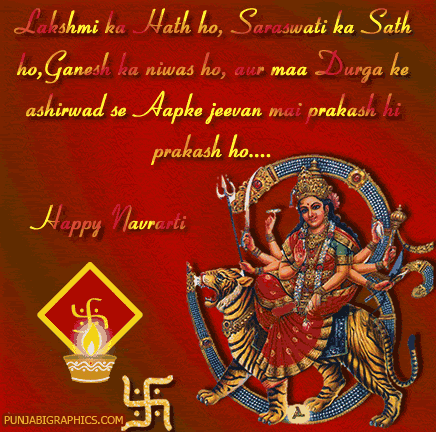Skandamata, or the mother of Kumar Skanda, is worshiped on the fifth day of Navratri. As a symbol of fertility, motherhood, mother-child relationships and endurance, she is often depicted holding her six-headed-son in her lap. Worshiping this goddess is believed to bring purity of mind, as her devotees enter the Vishudh Chakra i.e., a state of being in undiluted thoughts. After attaining their true desires, worshipers shout the slogan "Jai Skandamata".

Skandamata.
Origin and Deification of the Maternal Form
According to Hindu mythology, when all devtas (deities), manushya (mankind) and rishis (sages) were tired by the atrocities of demon Tarkasur, they sought help from Brahma to help end this demon's tyranny. Brahma, who was earlier pleased by the hard penance of Tarkasur, granted him with the boon of invincibility from all, except Lord Shiva's son. Upon being urged by all the devtas, Lord Shiva agreed and got married to Parvati, the daughter of Himalaya and later, their son Skanda destroyed the demon. Being the mother of such a valiant son, Goddess Parvati came to be known as Skandamata. This devi became the fifth form of Goddess Durga.
Remarkable Appearance of Ma Durga's Fifth Manifestation
One can easily tell apart this manifestation of Durgadevi from her other forms by looking at her appearance. This fair or shubra (white) complexioned, three-eyed and four-armed deity is seen mounted on a ferocious lion while holding two lotus flowers in each of her upper two arms. With her lower right hand, she holds her son Skanda, while her other hand is raised in Abhay mudra to bestow blessings upon her seekers.
It's believed that she usually sits on a lotus flower while meditating. Because of this, she is also known as Padamasani and Vidyavahini.
How to invoke, worship and perform rituals on Navratri Panchami
Devotees invoke the blessings of Skandamata Devi through chanting mantras, fasting and praying. Several other deities are also worshiped along with her on Navratri Panchami (fifth day) for their blessings.
During early morning hours, the portrait of this deity is decorated with good clothes and embellishments. The beginning of this day is marked with devotees offering her sweets and money. All the chapters of Durga Saptashi', a religious book, are read on this auspicious occasion as well.
- The Mantra
Worship of this goddess begins with the chanting the following mantra:
Sinhasan Gata Nitayam, Padmashrit Kardvaya |
Shubhdastu Sada Devi, Skanda Mata Yashashvini ||
Meaning: "Skandamata, who rides on Lion with Kartikeya, holds a lotus in her two hands and Varmudra (pose to grant boon) in one hand, be propitious to me."

Devotees offering early morning Skandamata puja in Gujarat.
- Worshiping Other Deities
It is said that worshiping Skandamata is incomplete without the worship of her Skanda. In Sanskrit, Skanda means six-headed and corresponds to the mind, as well as the five senses. It also refers to a person who can control vices like krodh (anger), mada (ego), lobh (greed) and matsarya (jealousy). Lord Shiva, Brahma and Lakshmi Devi are also invoked for their blessings on this day.
























comment:
p_commentcount